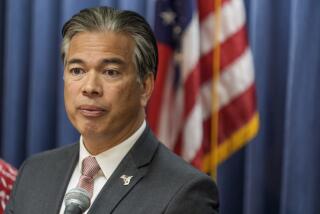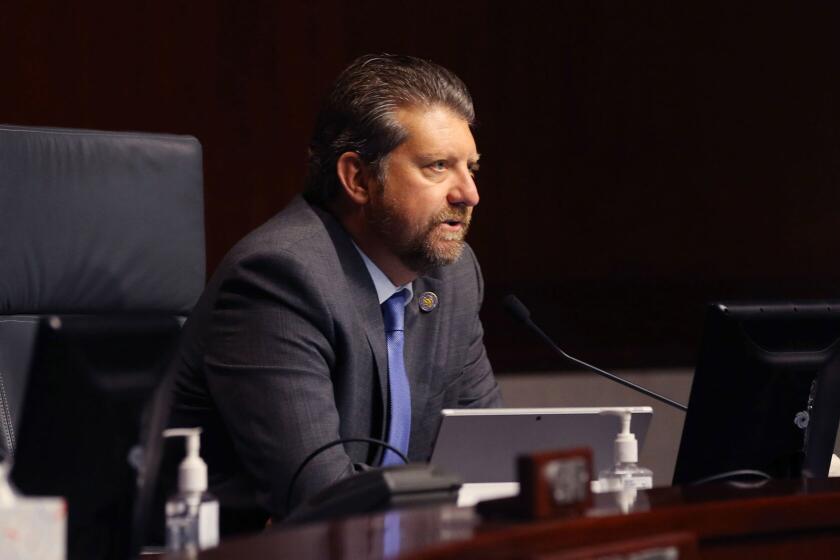Santa Paula Agrees to Settle Federal Suit
- Share via
The Santa Paula City Council voted unanimously Tuesday to settle a federal lawsuit by agreeing to allow voters in this mostly Latino city to decide whether to maintain at-large elections or switch to a district system.
The settlement brings to an end a three-year probe that divided white and Latino leaders and cost this financially strapped city at least $500,000 in legal fees.
After a half-hour meeting behind closed doors, the council voted 5 to 0 to accept the U.S. Department of Justice’s offer to drop the voting rights lawsuit filed in April 2000 before it goes to trial.
In exchange, the city will give voters in this community of 29,000 the final say on whether to continue with an at-large election system or follow the federal government’s recommendation to create a district system in which council members represent specific neighborhoods.
The ballot question will go before voters in November 2002.
Mayor Don Johnson said the settlement should lift a cloud of racial tension that has plagued the city and allow voters to exercise their will.
“This has been a long time coming,” Johnson said. “We need to put this behind us. I’ve thought from the very beginning this should go to the voters.”
The federal lawsuit alleged that the city’s at-large voting system violated the Voting Rights Act of 1965 and perpetuated racial discrimination by preventing Latino candidates from being elected to the council.
Councilwoman Laura Flores Espinosa, one of two Latinos on the council, also welcomed an end to the dispute.
“I’m looking forward to the community coming together and starting the healing process and the education process,” she said.
At the urging of Espinosa, the City Council also agreed Tuesday to spend $50,000 on a nonpartisan voter registration drive aimed at educating residents on the importance of voting and to conduct seminars on the difference between at-large elections and a district system.
As part of the settlement agreement, the council will consider placing one of the following options on the ballot: to create five single council districts; to create four single council districts and have the mayor elected at-large; or to create two two-member council districts and have the mayor elected at-large.
Some Latino advocates who held out hope that the federal government would force the city to draw districts expressed disappointment with the terms of the settlement, saying it may be difficult to mobilize voters around such an abstract issue.
“We are not in favor of an election at this point,” said David Rodriguez, district director for the local chapter of the League of United Latin American Citizens. “We don’t feel the electorate is sufficiently informed or involved in the process.”
Rodriguez said his group plans to launch its own campaign to educate voters before the election.
Justice officials and civil rights activists have contended that a district system would yield better representation for Latinos, partly because many neighborhoods in the city are almost entirely Latino.
School Board Has Latino Majority
Historically, those critics said, the at-large system has diluted the collective will of Latino voters in the city. Yet the local school board, whose members are also elected at-large in a nearly identical voter boundary, has had a Latino majority for years.
The city is two-thirds Latino, but a much smaller proportion of Latinos are registered to vote and an even smaller proportion turn out in elections. Whites have dominated the council throughout the city’s history, and no more than two Latino members have served on the five-member council at one time.
The federal government has never made public what prompted its investigation. It began looking at the city’s election process in 1998, as city officials were considering a massive annexation that could have quadrupled the city’s size.
Some Latino activists contended that the expansion would have mainly attracted wealthy white residents, preventing Latinos’ ascent to power and forever changing the makeup of the city.
Federal officials began examining city voting patterns. The following year the investigation became public after Justice officials urged the city to voluntarily change its elections system or face litigation.
Although the city was struggling financially, most council members balked at being forced into a corner and at what they perceived as accusations of institutional racism.
Rather than meeting the government’s demands, they hired attorney John McDermott, who specializes in voting rights cases, to defend them in case the federal government followed through on its threat.
When the Department of Justice sued, Espinosa was the only Latino on the council, and the Latino voting population in the city was estimated at 45%.
Since then, several shifts have occurred that critics of the lawsuit say weakened the federal government’s case. Voters last year elected a second Latino to the council, Ray Luna, as well as a white council member who enjoyed support from Latino voters.
Slow-Growth Measure Blocked Annexation
City voters also passed Measure I, a slow-growth initiative that blocks annexation plans unless voters specifically approve them.
Meanwhile, using updated voter information and special computer software that searches by surname, city officials now estimate Latinos compose 52% of the city’s registered voters.
More to Read
Sign up for Essential California
The most important California stories and recommendations in your inbox every morning.
You may occasionally receive promotional content from the Los Angeles Times.










